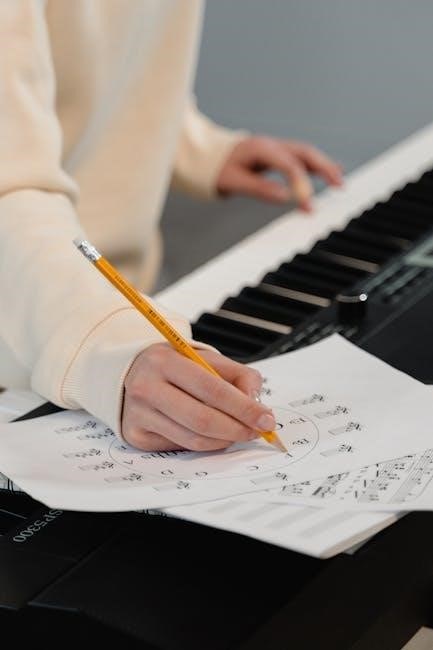carol of the bells sheet music pdf piano
Carol of the Bells‚ with its haunting melody and intricate rhythms‚ is a beloved holiday piece originating from a Ukrainian folk song. Its popularity endures‚ with sheet music widely available for piano in various arrangements.
1.1 Brief Overview of the Piece
Carol of the Bells‚ composed by Mykola Leontovych‚ is a captivating piece based on a Ukrainian folk chant. Its haunting melody and rhythmic complexity make it a holiday classic. The piece features a distinctive four-note ostinato‚ creating a bell-like effect‚ and is often performed during Christmas celebrations. Available in various arrangements‚ it suits pianists of all skill levels‚ from easy versions for beginners to advanced interpretations. Sheet music in PDF and MIDI formats is widely accessible‚ allowing pianists to explore its nuances. The arrangement by Julie A. Lind is particularly popular‚ offering a structured approach for performers. This piece remains a timeless favorite‚ blending cultural heritage with musical brilliance.
1.2 Importance of Sheet Music in Performance
Sheet music is essential for accurately performing Carol of the Bells‚ ensuring precision in melody‚ harmony‚ and rhythm. It provides a clear guide for pianists to interpret the piece’s intricate ostinato patterns and dynamic shifts. With sheet music‚ performers can access arrangements tailored to their skill level‚ from easy to advanced versions. PDF and MIDI formats are widely available‚ offering convenience for practice and performance. Sheet music also enhances expression by highlighting phrasing‚ articulation‚ and tempo markings. For pianists aiming to master this piece‚ sheet music is a vital tool‚ enabling them to deliver a polished and emotionally resonant performance while staying true to the composer’s intent.

History and Origins
Carol of the Bells‚ originally a Ukrainian folk song titled Shchedryk‚ was composed by Mykola Leontovych in 1916. It was later adapted by Peter Wilhousky‚ gaining global popularity as a Christmas carol.

2.1 Composition Background and Creator
Carol of the Bells‚ originally titled Shchedryk‚ was composed by Mykola Leontovych in 1916. It was based on a traditional Ukrainian folk chant and initially performed by the Ukrainian Republic Choir. Leontovych‚ a renowned Ukrainian composer‚ drew inspiration from the country’s rich musical heritage. The piece gained international acclaim after Peter Wilhousky arranged it in 1936‚ adapting it into the Christmas carol known today. Wilhousky’s arrangement transformed the work‚ blending its haunting melody with festive lyrics; This collaboration bridged Ukrainian folklore with global holiday traditions‚ making Carol of the Bells a timeless classic celebrated worldwide.
2.2 Evolution of the Carol Over Time

Since its creation‚ Carol of the Bells has evolved significantly‚ transitioning from a traditional Ukrainian folk song to a globally recognized Christmas carol. Initially composed by Mykola Leontovych in 1916‚ the piece was later arranged by Peter Wilhousky in 1936‚ introducing English lyrics that tied it to the holiday season. Over the years‚ it has been adapted into various genres‚ from classical to pop‚ and arranged for diverse instruments. The carol’s haunting melody and rhythmic complexity have made it a favorite for pianists‚ with arrangements ranging from simple to advanced. Its versatility has led to countless interpretations‚ ensuring its enduring popularity in holiday performances and modern adaptations.
Piano Arrangements
Piano arrangements of Carol of the Bells are available in easy‚ intermediate‚ and advanced versions‚ offering accessibility for all skill levels. PDF and MIDI formats are widely available.

3.1 Easy Piano Version for Beginners
The easy piano version of Carol of the Bells is designed for beginners‚ simplifying the iconic melody and rhythms into manageable notes. This arrangement retains the piece’s essence while reducing complexity‚ making it accessible for those with limited experience. Free sheet music in PDF and MIDI formats is widely available online‚ allowing learners to practice at their own pace. Many versions include fingerings and tempo guides to aid mastery. Beginners can start with a slow tempo and gradually increase speed as confidence grows. Resources like Musicnotes and Sheet Music Plus offer reliable downloads‚ ensuring a smooth learning process. This version is a great introduction to the piece’s beauty and cultural significance.
3.2 Intermediate Piano Version
The intermediate piano version of Carol of the Bells offers a balance between challenge and accessibility‚ introducing more complex techniques while maintaining the piece’s recognizable melody. This arrangement often includes arpeggios‚ chord progressions‚ and dynamic variations‚ allowing pianists to refine their skills. Sheet music in PDF format is readily available online‚ with platforms like Musicnotes and Sheet Music Plus providing high-quality downloads. Intermediate players can explore nuanced expressions and rhythmic precision‚ enhancing their musicality. The version is ideal for those seeking to expand their repertoire while mastering intermediate-level piano techniques. It bridges the gap between simplicity and advanced playing‚ making it a rewarding step in musical growth.
3.3 Advanced Piano Version
The advanced piano version of Carol of the Bells showcases intricate arrangements‚ demanding technical proficiency and artistic expression. This version often features complex arpeggios‚ rapid chord progressions‚ and dynamic variations‚ creating a dramatic and captivating performance. Sheet music in PDF format is available for advanced pianists‚ with arrangements by composers like Julie A. Lind and santidadejona offering unique interpretations. The advanced version emphasizes nuanced phrasing‚ precise timing‚ and mastery of dynamics‚ making it a thrilling challenge for skilled pianists. It highlights the piece’s full emotional depth‚ blending traditional melodies with virtuosic elements. This arrangement is perfect for pianists seeking to showcase their technical and musical abilities‚ delivering a powerful rendition of the beloved carol.

Downloading Sheet Music
Sheet music for Carol of the Bells is readily available in PDF and MIDI formats from various online sources‚ offering easy access to arrangements for piano performance.
4.1 Sources for PDF Sheet Music
Several reputable websites offer high-quality PDF sheet music for Carol of the Bells. Platforms like Musicnotes‚ SheetMusicPlus‚ and MuseScore provide a wide range of arrangements for piano. These sites often feature both free and paid versions‚ catering to different skill levels and preferences; Additionally‚ websites like PDFMinstrel and 8notes specialize in classical and holiday pieces‚ making them excellent resources for this carol. Many of these platforms allow users to preview the sheet music before downloading‚ ensuring compatibility with their musical needs. With just a few clicks‚ pianists can access and print professional-quality arrangements of Carol of the Bells in PDF format‚ making it easy to start practicing and performing this beloved piece.
4.2 Tips for Downloading and Printing
When downloading Carol of the Bells sheet music in PDF format‚ ensure you select the correct arrangement for your skill level. Use a reliable PDF viewer like Adobe Acrobat for compatibility. Before printing‚ choose the appropriate paper size and orientation to fit the music notation. Adjust margins to prevent cropping of musical notes. Check the website’s guidelines for printing permissions to avoid copyright issues. For clarity‚ use high-quality print settings and consider using sheet music paper for a professional finish. Finally‚ save a digital copy as a backup to avoid re-downloading. These steps ensure a seamless and high-quality printing experience for your piano performance.

Performance Tips
Focus on dynamics and rhythm to enhance the haunting melody. Emphasize precise timing and expression to capture the piece’s emotional depth and intricate musical layers effectively.
5.1 Musical Interpretation and Style
Carol of the Bells demands a nuanced approach‚ blending dynamics and rhythm to highlight its haunting melody. Pianists should emphasize the contrast between soft‚ delicate passages and powerful‚ resonant chords. The piece’s intricate rhythms require precise timing‚ while expressive phrasing can enhance its emotional depth. Pay attention to pedaling techniques to maintain a lush‚ ethereal sound. Balancing melody and harmony is crucial‚ as the interplay between voices creates the song’s signature texture. For a dramatic effect‚ pianists can experiment with rubato in slower sections‚ adding a touch of personal interpretation. Ultimately‚ the goal is to capture the piece’s mystical essence while maintaining technical accuracy and musicality.

5.2 Common Challenges and Mistakes
Performing “Carol of the Bells” presents several challenges‚ particularly in maintaining precise rhythm and timing. The piece’s intricate syncopation and layered melodies can lead to errors if not practiced thoroughly. Many pianists struggle with balancing dynamics‚ often underplaying the subtle shifts between soft and loud passages. Additionally‚ the rapid arpeggios and chord progressions require strong finger dexterity and hand coordination‚ which can be daunting for intermediate players. A common mistake is rushing through the faster sections‚ disrupting the piece’s haunting flow. Overlooking pedaling instructions can also diminish the ethereal quality of the music. To avoid these pitfalls‚ focus on slow‚ deliberate practice and attention to musical markings to ensure a polished performance.
Cultural Impact
Carol of the Bells has become a global holiday classic‚ featured in films‚ commercials‚ and performances worldwide‚ transcending cultural boundaries with its timeless‚ evocative melody.
6.1 Popularity in Holiday Performances
Carol of the Bells is a staple in holiday performances worldwide‚ captivating audiences with its mesmerizing melody and rhythmic complexity. Its universal appeal makes it a favorite for concerts‚ school events‚ and church services. The piece’s adaptability to various instruments‚ particularly the piano‚ has further cemented its place in festive repertoires. Many artists and ensembles feature it in their holiday programs‚ often drawing large audiences. Its haunting beauty evokes a sense of nostalgia and joy‚ making it a timeless holiday classic. The availability of sheet music in PDF formats for piano has also made it accessible to performers of all skill levels‚ ensuring its continued popularity in holiday celebrations.
6.2 Modern Adaptations and Covers
Carol of the Bells has inspired countless modern adaptations and covers‚ showcasing its timeless appeal. Artists across genres have reimagined the piece‚ from orchestral arrangements to rock and jazz interpretations. Notably‚ a “Dark Piano Version” has gained popularity‚ offering a haunting twist on the classic melody. Many contemporary pianists and composers create their own arrangements‚ blending traditional elements with modern styles. These adaptations often feature in films‚ commercials‚ and holiday playlists‚ introducing the carol to new audiences. The availability of sheet music in PDF formats for piano has further fueled creativity‚ allowing performers to experiment with unique interpretations while preserving the song’s core essence. This versatility ensures its enduring relevance in modern music culture.
Resources and Tools

Recommended websites like Musicnotes and Sheet Music Plus offer high-quality PDF sheet music for Carol of the Bells. Software like MuseScore aids in editing and playback‚ enhancing practice and performance.
7.1 Recommended Websites for Sheet Music
For high-quality Carol of the Bells sheet music‚ websites like Musicnotes‚ Sheet Music Plus‚ and MuseScore are excellent resources. These platforms offer a wide range of arrangements‚ from easy to advanced levels‚ ensuring suitability for all pianists. Many provide free PDF and MIDI downloads‚ while others offer premium options with additional features. Musicnotes often includes MIDI previews‚ allowing users to hear the piece before downloading. Sheet Music Plus offers user ratings‚ helping pianists choose the best arrangements. MuseScore stands out for its community-driven content‚ with contributions from talented arrangers worldwide. These websites cater to diverse skill levels‚ making them invaluable for pianists seeking accurate and engaging sheet music for Carol of the Bells.
7.2 Software for Editing and Playback
Software like MuseScore‚ Finale‚ and Sibelius are indispensable for editing and playback of Carol of the Bells sheet music. These tools allow pianists to modify arrangements‚ adjust tempos‚ and add dynamics. MuseScore is particularly popular for its user-friendly interface and ability to import PDF and MIDI files. Finale and Sibelius offer advanced features for professional-grade editing. Additionally‚ GarageBand and Logic Pro enable MIDI playback‚ helping pianists hear the piece before performance. These software options empower musicians to refine their interpretations and enhance their practice sessions‚ ensuring a polished and expressive delivery of Carol of the Bells.

Musical Structure
The piece features a haunting melody with a descending contour‚ shared between hands‚ and a harmonic structure rich in minor keys‚ creating a sense of tension and resolution. The rhythmic patterns‚ including syncopation and bell-like arpeggios‚ add complexity and dynamic energy‚ making it a compelling work for pianists to interpret and perform.
8.1 Melody and Harmony Analysis
The melody of “Carol of the Bells” is haunting and iconic‚ characterized by a descending contour that creates a sense of urgency and drama. The harmonic structure is rooted in minor keys‚ evoking a somber yet majestic atmosphere. The interplay between the melody and harmony is intricate‚ with the melody often moving in stepwise motion while the harmony shifts beneath it‚ creating moments of tension and resolution. The piece also features bell-like arpeggios that mimic the ringing of bells‚ adding a layer of texture and depth. The harmonic progression‚ particularly the use of modulations‚ enhances the emotional impact of the melody‚ making it a compelling study for pianists;
8.2 Rhythmic Patterns and Timing
The rhythmic patterns in “Carol of the Bells” are a defining feature‚ with a driving‚ repetitive motif that mimics the ringing of bells. The primary rhythmic figure is a descending sequence of eighth notes‚ often syncopated to create a sense of urgency. This pattern is repeated and layered‚ building intensity and complexity. The timing is typically in a steady 4/4 meter‚ though subtle variations in accentuation and phrasing add depth. Pianists must pay close attention to maintaining a consistent rhythm while navigating dynamic contrasts. The interplay between arpeggiated chords and melodic lines requires precise timing to preserve the piece’s energy and clarity. Mastering these rhythmic elements is essential for a compelling performance.
Practice Techniques
Effective practice involves breaking the piece into sections‚ focusing on challenging passages‚ and using slow tempos to build accuracy. Incorporate dynamics and articulation for expressive performance.
9.1 Building Dexterity and Speed
Mastering Carol of the Bells requires focused practice to enhance finger dexterity and speed. Begin with slow tempos‚ gradually increasing as comfort grows. Use Hanon exercises or scales to strengthen finger independence. Incorporate metronome practice to maintain precise timing and rhythm. Isolate challenging passages‚ such as rapid arpeggios or intricate runs‚ and practice them repeatedly until smooth. Pay attention to hand positioning and finger placement to avoid fatigue. Consistent‚ methodical practice will build the technical proficiency needed for a polished performance. Over time‚ these exercises will improve both speed and accuracy‚ allowing for a captivating rendition of this beloved piece.
9.2 Mastering Dynamics and Expression
Mastering dynamics and expression in Carol of the Bells is essential for a compelling performance. Pay close attention to the sheet music’s markings‚ such as crescendos and decrescendos‚ to convey the piece’s dramatic contrasts. Practice playing with varying dynamics‚ from soft‚ delicate passages to powerful‚ resonant chords. Expression can be enhanced by subtly adjusting tempo and phrasing‚ particularly in the melody’s haunting motifs. Use rubato sparingly to add emotional depth without losing rhythmic clarity. Focus on balancing the interplay between hands‚ ensuring the melody shines while the accompaniment supports it. Recording your practice can help identify areas for refinement. By mastering these elements‚ you’ll deliver a performance that captivates and moves your audience.
Carol of the Bells remains a timeless‚ captivating piece‚ with its sheet music readily available for pianists of all levels. Embrace its beauty and emotional depth.
10.1 Final Thoughts on Performance
Performing Carol of the Bells requires a balance of technical precision and emotional expression. Pianists should focus on mastering dynamics‚ as the piece’s dramatic contrasts are key to its impact. The intricate rhythms and layered harmonies demand careful practice to ensure clarity and timing. Emphasize the haunting melody while maintaining rhythmic accuracy‚ as this creates the piece’s signature tension and beauty. Encourage pianists to connect with the music’s emotional depth‚ allowing the audience to feel its powerful resonance. With dedication and attention to detail‚ performers can deliver a captivating rendition that honors the piece’s timeless appeal.
10.2 Encouragement for Aspiring Pianists
Embarking on Carol of the Bells is a rewarding journey for pianists of all levels. Beginners can start with simplified arrangements‚ gradually building skill and confidence. The piece’s structure allows for steady progress‚ making it an excellent choice for improving dexterity and musicality. Aspiring pianists should embrace the challenge of mastering its intricate rhythms and dynamics‚ as these elements are key to its emotional impact. With consistent practice‚ even the most complex versions become achievable. Remember‚ the joy of performance lies not only in technical perfection but in conveying the music’s haunting beauty. Every note brings you closer to a captivating interpretation‚ making the effort deeply fulfilling.

